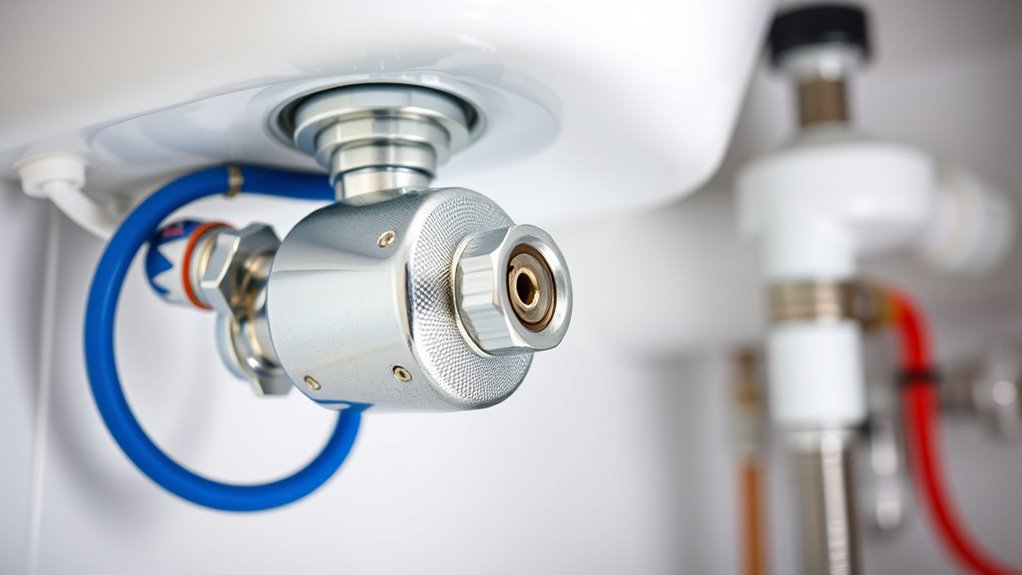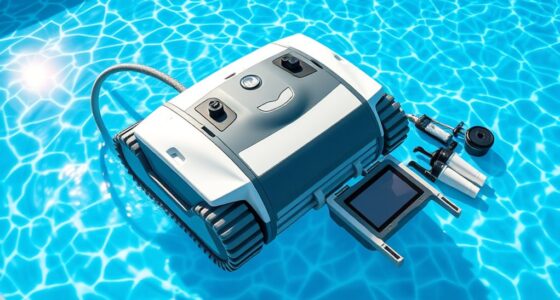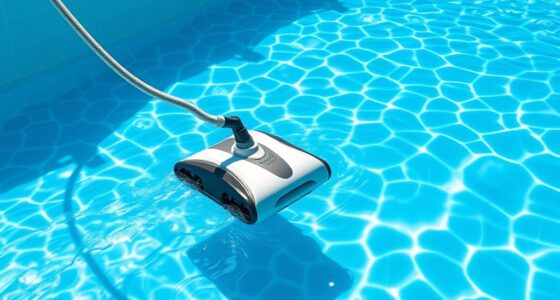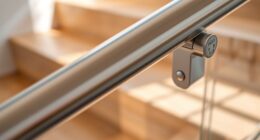If your water pressure drops below 40 psi, causes slow flow, or fixtures take longer to fill, you likely need a booster pump. Signs include inconsistent pressure and sluggish water delivery. A booster pump can improve flow and guarantee consistent pressure for household tasks. Before deciding, consider your current pressure and plumbing setup. If you’re unsure, explore more about which pump suits your needs and how to install it effectively.
Key Takeaways
- Low, inconsistent water pressure or slow fixture fill times suggest a booster pump may be needed.
- If your household water pressure drops below 40 psi during peak use, a booster pump can help maintain steady flow.
- Long pipe runs or outdated, corroded pipes can cause pressure issues that a booster pump can address.
- In multi-story buildings or large homes, booster pumps ensure sufficient water pressure at all levels.
- Consider installing a booster pump if water conservation habits or debris buildup are causing flow restrictions.
Common Signs That Indicate Low Water Pressure
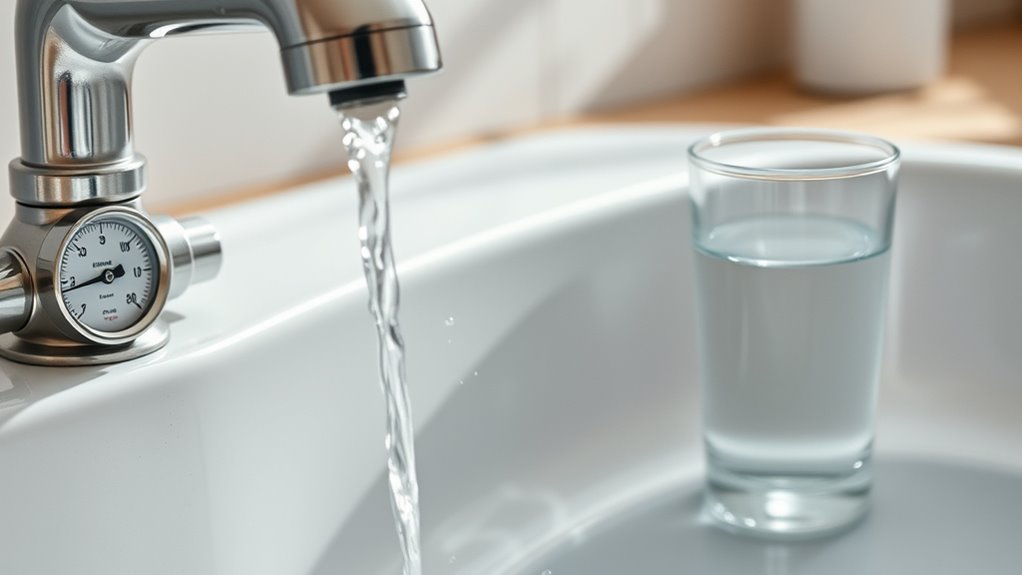
Low water pressure can be frustrating and disruptive to your daily routine. You might notice it when taking a shower, washing dishes, or watering your garden. Reduced flow often signals a problem that needs attention. One common sign is inconsistent water pressure, which varies throughout the day or between fixtures. Low pressure can also cause longer fill times for sinks and tubs. Sometimes, outdated pipe material can contribute to the issue, especially if pipes are corroded or clogged. Additionally, poor water conservation habits or debris buildup can restrict flow. Recognizing these signs early helps prevent further damage and guarantees your plumbing system functions smoothly. Addressing the root cause, whether it’s pipe material or other factors, can restore ideal water pressure and save you from future headaches. Regular maintenance and inspections can also help identify potential issues before they become major problems. Being aware of pipe corrosion and other signs can help you take timely action to maintain optimal water flow. Moreover, installing a booster pump might be necessary if your water pressure remains consistently low despite addressing other causes. In some cases, advanced plumbing technologies can also improve overall water delivery efficiency.
How Booster Pumps Improve Water Flow
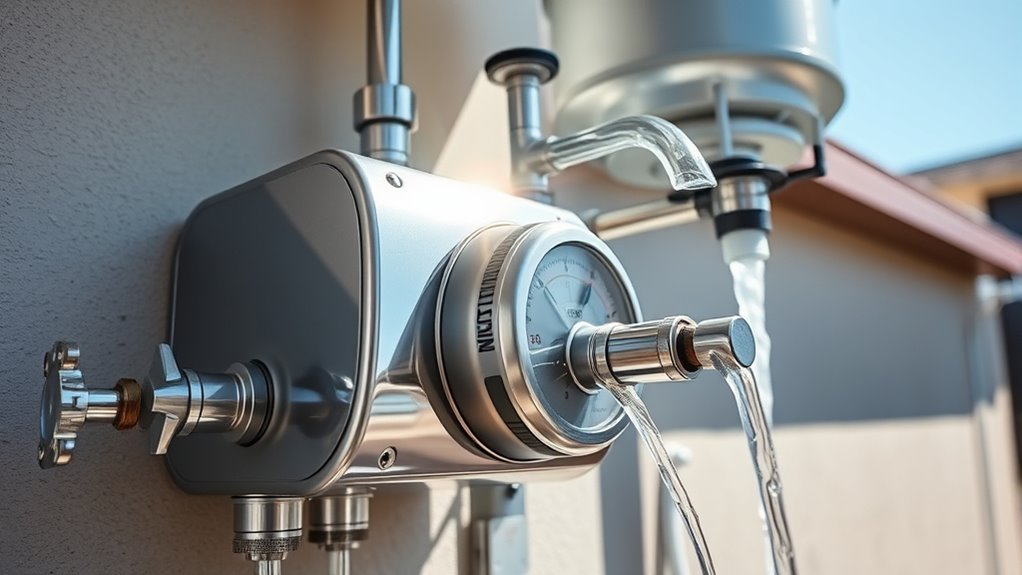
When water pressure drops, it can be frustrating to experience weak or inconsistent flow at multiple fixtures. A booster pump improves water flow by increasing water pressure directly at the source, ensuring steady delivery throughout your system. It works by actively pushing water through pipes, overcoming resistance caused by long distances or low supply pressure. This enhancement means your fixtures receive a more consistent flow, making everyday tasks easier. Plus, a well-designed booster pump improves pump efficiency, reducing strain on your plumbing system and lowering energy consumption. As a result, you enjoy stronger water pressure without sacrificing performance or wasting energy. Additionally, understanding growing and harvesting chia seeds can promote self-sufficiency and healthier eating habits. Proper installation and regular maintenance also play vital roles in maintaining optimal water pressure, ensuring your system functions reliably over time. Regularly inspecting and servicing your pump can prevent issues caused by clogged filters or leaks, safeguarding your water supply. Overall, a booster pump optimizes your water flow, providing reliable, high-pressure water whenever you need it.
Factors to Consider Before Installing a Booster Pump
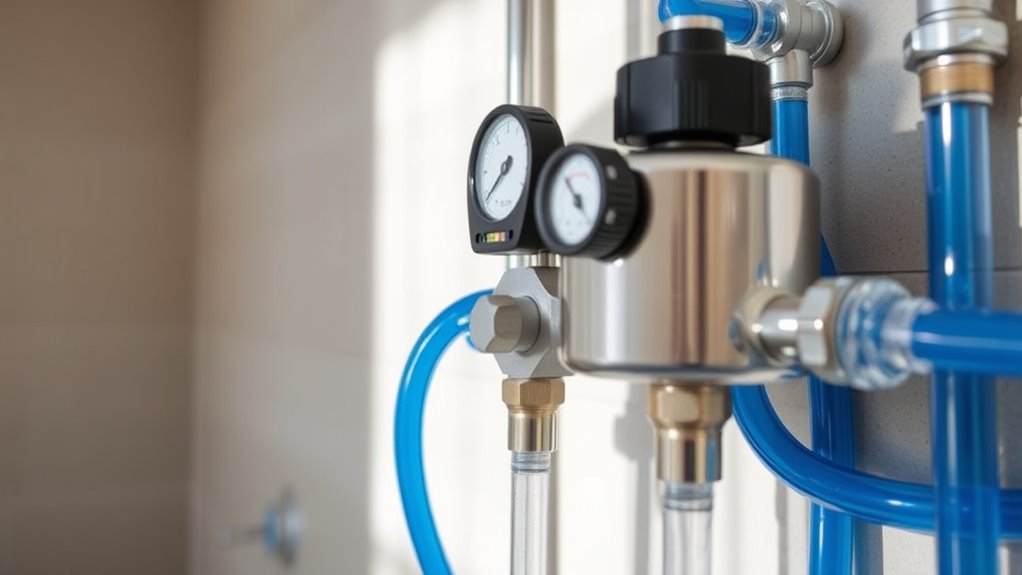
Before installing a booster pump, you need to assess your water pressure needs to guarantee it provides adequate flow. You should also consider the installation costs and whether your existing system is compatible with the new pump. Taking these factors into account helps you choose the right pump and avoid costly mistakes. Additionally, understanding the importance of eco-friendly practices can ensure that your water heating solutions are sustainable and environmentally responsible. Being aware of signs of spoilage in your water supply, such as discoloration or off-smell, can help maintain water quality and system efficiency. Conducting a pressure test with a gauge can provide valuable insights into your system’s performance before making a purchase. Incorporating well-being tips related to water quality and system maintenance can also promote overall health and safety.
Water Pressure Needs
How do you determine if your water pressure is sufficient for your needs? First, check your current water pressure with a pressure gauge—aim for at least 40 psi for most household tasks. If your pressure drops during peak usage, a booster pump might help. Consider your water conservation habits; if you often run multiple fixtures simultaneously, higher pressure ensures consistent flow. Also, evaluate your pipe material—rigid pipes like copper handle pressure better than flexible plastics, reducing pressure loss. If your water flow feels weak or inconsistent, and your pipes are prone to pressure drops, a booster pump could improve your experience. Remember, adequate water pressure not only enhances daily tasks but also prevents damage to your plumbing system. Ensure your water pressure aligns with your household needs before deciding on a booster pump. Additionally, understanding family photoshoot fails can remind you that unexpected issues with your plumbing can sometimes lead to humorous or problematic situations, so proper pressure management is essential.
Pump Installation Costs
Installing a booster pump involves several cost factors you should consider to avoid surprises. First, the quality of your water impacts installation costs; poor water quality may require additional filtration systems, increasing expenses. Vetted Water treatment options can help mitigate these issues and improve overall system efficiency. Energy efficiency is another key consideration, as a more efficient pump may have a higher upfront cost but lower long-term energy bills. You’ll also need to factor in the cost of professional installation, which can vary based on your home’s plumbing complexity. Proper sizing and setup are essential to prevent future issues, so investing in quality equipment and skilled labor can save money over time. Additionally, selecting a pump with suitable capacity ensures optimal performance and longevity, reducing the need for costly replacements or repairs. Choosing a pump with proper controls can also enhance energy savings and operational flexibility. Moreover, understanding the role of attention in the installation process can help ensure that the setup is done correctly the first time, preventing costly mistakes. It is also beneficial to consider environmental factors, such as water source quality, which can affect the pump’s performance and maintenance needs. Overall, understanding these factors helps you budget effectively and ensures your booster pump operates reliably and efficiently.
System Compatibility Factors
Ensuring your booster pump is compatible with your existing plumbing system is vital for a smooth installation and reliable operation. Key factors to contemplate include:
- System Compatibility: Check if your current pipes and fittings can accommodate the pump without major modifications. Reviewing plumbing system compatibility can help identify potential issues beforehand.
- Pump Sizing: Accurate pump sizing is essential to meet your water pressure needs without overworking the system or wasting energy.
- Flow Rate and Pressure: Make sure the pump can deliver the desired flow rate and pressure compatible with your household demands.
- Proper Storage and Maintenance: Regularly storing and maintaining your pump and related components can prevent issues such as sediment formation and ensure optimal performance. Consistent maintenance extends the lifespan of your pump and maintains efficiency.
Types of Booster Pumps Available in the Market
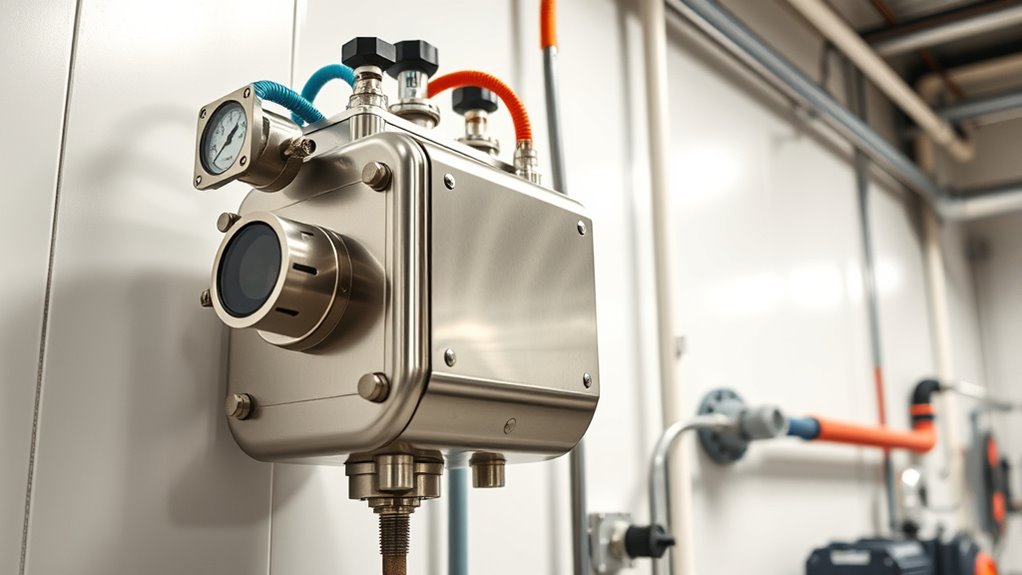
There are several types of booster pumps available in the market, each designed to meet specific water pressure and flow needs. When considering pump selection, it’s important to understand the differences. Centrifugal pumps are common and ideal for high flow rates, providing steady water pressure. Multistage pumps are suitable for higher pressure applications, often used in taller buildings. Positive displacement pumps deliver consistent pressure regardless of flow variations, making them great for precise pressure control. Vertical turbine pumps are used for large-scale water systems, especially in municipal or industrial settings. Choosing the right type depends on your water pressure requirements and flow demands. Understanding these options can help you select a booster pump that optimizes performance and guarantees reliable water delivery for your needs. Additionally, understanding pump technology can help you choose the most efficient and durable option for your specific application. Optimizing pump efficiency can also lead to energy savings and longer equipment lifespan. Recognizing the personality traits of different pump types can assist in making an informed decision tailored to your operational needs. Moreover, considering wall organization systems can help streamline your home’s water management and overall system maintenance.
Installation and Maintenance Tips for Booster Pumps
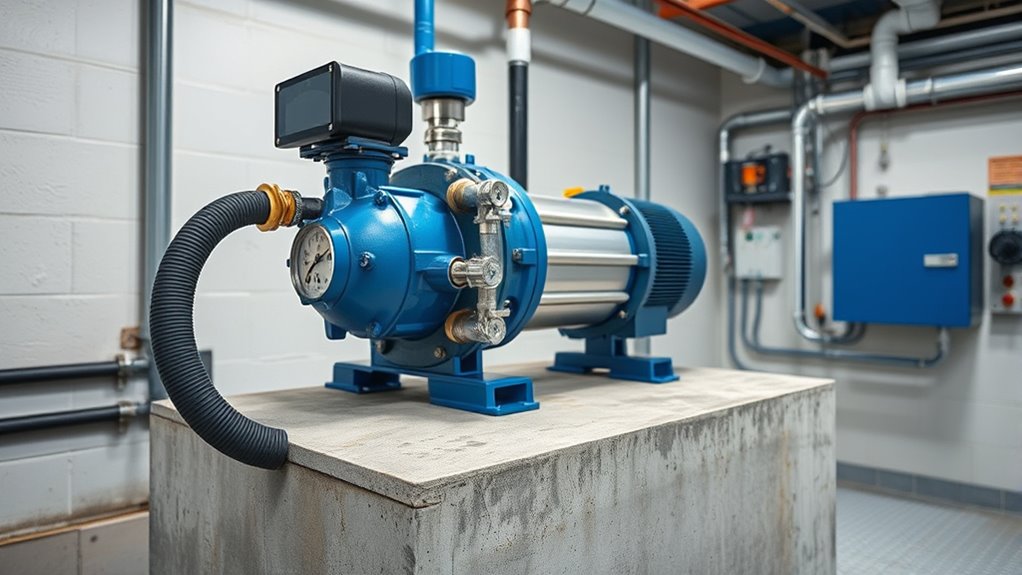
Getting your booster pump installed correctly is essential for peak performance, so follow proper procedures closely. Regular maintenance helps prevent issues and keeps the pump running smoothly, saving you time and money. When problems arise, troubleshooting common issues quickly ensures your system stays reliable and efficient.
Proper Installation Procedures
Have you ever wondered how proper installation can extend the life and performance of your booster pump? Correct setup ensures ideal water pressure and minimizes pump noise. To achieve this, follow these steps:
- Secure the pump on a stable, level surface to prevent vibrations that cause noise and damage.
- Ensure proper piping layout with adequate inlet and outlet connections, avoiding sharp bends to maintain water pressure enhancement.
- Install a pressure relief valve and check valves to prevent pressure spikes and protect the pump from damage.
Routine Maintenance Practices
Maintaining your booster pump regularly guarantees it operates efficiently and lasts longer. Start by inspecting the pump and pipes for leaks or corrosion, which can waste water and energy. Keep the area around the pump clean and free of debris to prevent overheating. To promote water conservation, check for leaks and fix them promptly; small leaks can lead to significant water loss over time. Insulating the pipes helps reduce heat loss, especially in colder months, ensuring the system runs efficiently. Regularly test the pump’s pressure and flow rates to identify issues early. Remember, routine maintenance not only prolongs the lifespan of your booster pump but also saves water and energy, making your system more sustainable and cost-effective.
Troubleshooting Common Issues
When your booster pump isn’t working properly, troubleshooting begins with identifying common issues that can disrupt its performance. First, check for air leaks or leaks in the piping, which can reduce efficiency and waste water. Second, inspect the pressure switch; if it’s faulty, the pump may not activate correctly, wasting energy. Third, ensure the pump’s inlet and outlet filters are clean; clogged filters restrict flow and increase energy use. Addressing these issues not only restores proper function but also promotes water conservation and eco-friendly solutions. Regular maintenance and quick troubleshooting can prevent unnecessary water waste and extend your pump’s lifespan. By staying vigilant, you keep your system running smoothly while supporting sustainable practices.
Alternatives to Using a Booster Pump
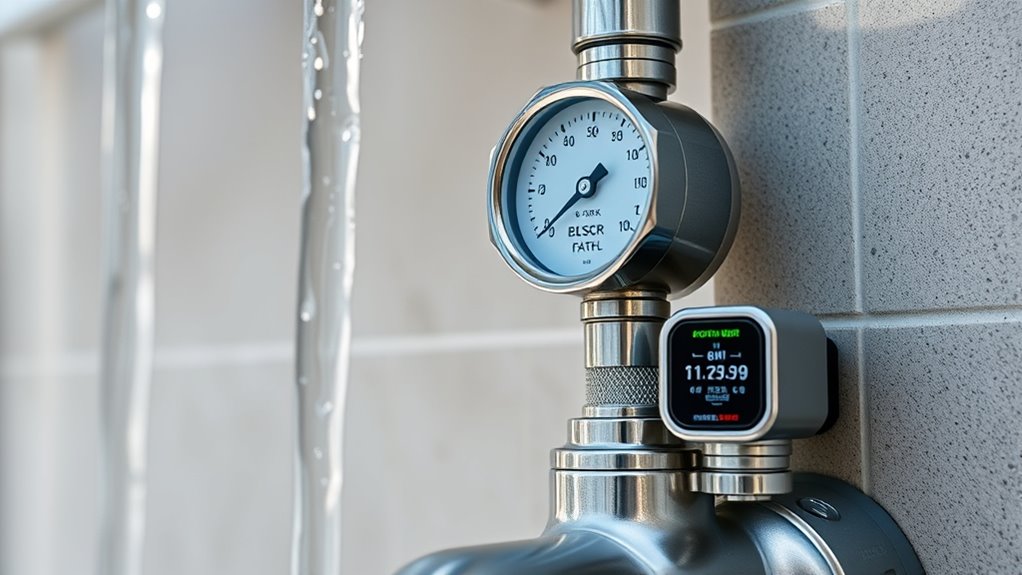
If you’re looking to improve water pressure without relying on a booster pump, several alternatives can help achieve similar results. Installing water saving devices, like aerators and low-flow fixtures, reduces water waste while maintaining adequate pressure. These devices optimize flow, making your system more efficient. Additionally, exploring alternative water sources, such as rainwater harvesting or connecting to a secondary supply, can supplement your main supply and boost pressure where needed. Upgrading your pipes to wider diameter ones reduces resistance and improves flow, too. Regular maintenance, like cleaning filters and checking for leaks, also enhances water pressure without extra equipment. These options can often be more cost-effective and environmentally friendly, giving you reliable water flow without the need for a booster pump.
Frequently Asked Questions
How Long Does It Take to Install a Booster Pump?
Installing a booster pump typically takes a few hours, depending on your home’s plumbing setup and pressure requirements. You’ll need to follow proper installation procedures, which include connecting the pump to your water supply and ensuring correct wiring. Factors like pipe complexity and whether you’re doing it yourself or hiring a professional can influence the time. Overall, plan for a short installation process that improves your water pressure efficiently.
What Is the Average Cost of a Booster Pump?
The average cost of a booster pump varies based on size and features, typically ranging from $200 to $1,000. Cost considerations include the pump’s capacity and installation requirements, which can influence the overall price. Keep in mind the installation timeframe, usually taking a few hours, so plan accordingly. You’ll want to balance your needs and budget to choose the right pump while ensuring timely setup.
Can Booster Pumps Be Used for Commercial Properties?
Sure, booster pumps are perfect for commercial properties—because who doesn’t want better water pressure? You’ll find they’re essential for maintaining adequate flow and ensuring your system works smoothly. Just remember, with great power comes great pump maintenance. Ignoring upkeep can lead to costly repairs. So, if you’re after consistent water pressure and want to avoid surprises, a booster pump is a smart choice for your commercial space.
Are There Energy-Efficient Booster Pump Options?
You’re wondering if there are energy-efficient booster pump options. Yes, many models now feature energy-saving alternatives and eco-friendly options, helping you reduce power consumption and lower utility bills. Look for pumps with variable speed motors, high-efficiency impellers, and smart controls that optimize performance. These upgrades not only save energy but also extend the pump’s lifespan, making them a smart, sustainable choice for your home or business.
How Often Should Booster Pumps Be Serviced?
You should service your booster pump regularly to guarantee ideal performance. Follow maintenance tips like checking for leaks, listening for unusual noises, and inspecting pressure levels. Refer to troubleshooting guides to identify issues early. Typically, it’s recommended to schedule professional inspections annually, but if you notice problems, address them promptly. Regular maintenance keeps your pump running smoothly, extends its lifespan, and prevents costly repairs down the line.
Conclusion
Think of a booster pump as a personal trainer for your home’s water pressure, giving it the extra push it needs. If you’re constantly battling low pressure, installing one can turn your water flow from a trickle to a steady stream. But remember, it’s not a one-size-fits-all solution—consider your needs carefully. With the right pump, you’ll enjoy a smooth, powerful flow that keeps your daily routines running seamlessly, like a well-oiled machine.
